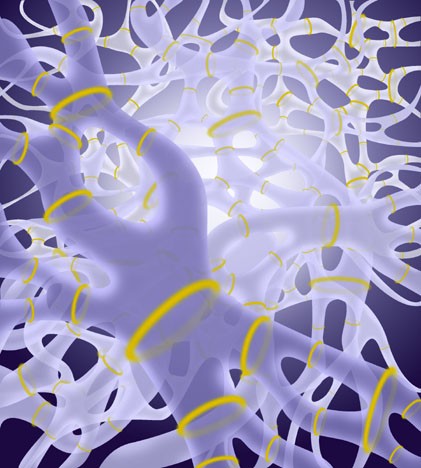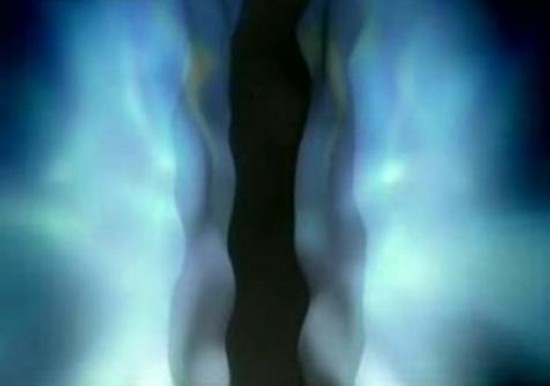
|
Main Topics > The Big Bang and the Big Crunch > Superstrings and Quantum Gravity
To fully understand questions like where the universe came from, why the Big Bang occurred 13.7 billion years ago and what, if anything, existed before it, we need to better understand singularities like those in black holes and the singularity which marked the birth of the universe itself. In order to achieve that, most scientists agree that a “quantum theory of gravity” (also known as "quantum gravity" or "unification" or the “theory of everything”) is needed, which combines the General Theory of Relativity (our current best theory of the very large) and quantum theory (our current best theory of the very small). These may seem like fundamentally incompatible concepts, and even Einstein, who devoted most of the latter part of his life to unification, came up short. But attempts are nevertheless continuing on several fronts to find just such a synthesis. In the 1970s, the strongest candidate for a unified theory was probably “supergravity”, a field theory combining the principles of supersymmetry and general relativity. But, although the approach appeared promising, it soon became apparent that the calculations involved were so long and difficult that it may never be provable. Around 1984, however, largely in response to a ground-breaking paper by Michael Green and John Schwarz, there was a remarkable change of opinion in the world of theoretical physics in favor of string theory (or, more specifically, superstring theory), a paradigm shift sometimes referred to as the "First Superstring Revolution".
String theory had first been posited in the late 1960s as a result of work by Gabriele Veneziano, Leonard Susskind and others. It views the basic building blocks of matter not as point-like particles but as unimaginably small one-dimensional vibrating “strings” of energy, which have length but no other dimension, like infinitely thin pieces of string or twine. A string may be open (i.e. have ends) or closed (i.e. joined up in loops), and the history of a string over time is represented by a two-dimensional strip (for open strings) or tube (for closed strings). There might seem to be an inconsistency between the idea of a universe composed of strings and the point-like particles we actually observe in experiments. However, this is because the strings are so tiny that we cannot resolve their shape, even with our best technology, so that they just appear to us as tiny featureless points, like the difference between a speck of dust seen with the naked eye and under a microscope. To give some idea of the scales involved, a string is as small compared to an electron as a mouse is to the whole Solar System (around 20 order of magnitude smaller). But the real beauty of string theory is that it looks on everything in the universe, all matter and all forces as well, as being made up of one single ingredient. Strings are composed of super-concentrated mass-energy which vibrate like violin strings, with each distinct vibration mode corresponding to a fundamental particle (such as an electron or a photon, etc). The emission or absorption of one particle by another is represented by the dividing or joining together of strings, and the forces acting on particles correspond to other strings linking the particle strings in a complex “web”. According to string theory, then, the universe is a kind of symphony and the laws of physics are its harmonies. The vibrations of strings, however, occur in a ten-dimensional world, with each one-dimensional point in our ordinary space actually consisting of a complicated geometrical structure in six dimensions, all wrapped up on the scale of the Planck length (the smallest distance or size about which anything can be known, approximately 1.6 × 10-35 meters). The vibratory quality of these tiny threads of energy is what replaces particles and fields in the quantum description of the universe. The strength of the vibrations is what we see in the world as mass, and the patterns of vibrations are the fundamental forces.
The speculation on incorporating additional dimensions into space-time goes back to the ideas of the Polish physicist Theodor Kaluza in 1919 and, independently, the Swedish physicist Oscar Klein in 1926. They asked why it was not possible that electromagnetism could be unified with gravity in a notional five-dimensional universe, or that perhaps the electromagnetic force may relate to some curvature in a fifth dimension, just as gravity is due to curvature in four-dimensional space-time, as demonstrated by Einstein’s General Theory of Relativity. In fact, string theory started out as a theory in an unbelievable 26 dimensions, and was reduced to the 10 dimensional theory known as superstring theory (shorthand for "supersymmetric string theory") after the discovery of a symmetrically-mathematical object called a “Calabi-Yao shape”. General Relativity, which implicitly interprets gravity as curvature in four-dimensional space-time, is built into the basic precepts of superstring theory in a way that may be consistent with quantum mechanics, and so it is hoped that the long-sought synthesis between gravity and quantum theory will naturally emerge. In fact, over ten dimensions (in which all but the four we are familiar with are “curled up” into tiny strings with diameters on the order of the Planck scale), it may even be possible that all the fundamental forces in nature can be accommodated into one “theory of everything”, known as quantum gravity. Superstring theory may also go some way towards explaining another problem which has dogged physicists for years: why gravity is so very weak compared to the other fundamental forces. If strings, which are too small for us to see or measure, incorporate other dimensions, then it has been posited that perhaps the effects of gravity can only be felt in their entirety at the level of higher dimensions which we cannot perceive. However, the very fact that strings are too small for us to see (and probably too small for us to EVER see) have led some to question whether string theory is science at all, or whether it falls into the realm of philosophy. The validation of superstring theory, though, is all in the mathematics, and it remains frustratingly abstract and theoretical, particularly as we are clearly not able to actually observe such tiny objects, nor to clearly visualize the multi-dimensional aspects. Moreover, at least five different and competing superstring theories have developed, none of which are conclusive, however elegant. Since Ed Whitten's contribution to the field in 1995, though, there is some evidence that the inclusion of an eleventh dimension might be able to reconcile these competing theories, to show them as being just five different way of looking at the same thing. It might also make superstring theory consistent with supergravity theory (which had been largely disregarded since the early 1980s). With the additional eleventh dimension, the fundamental building block of the universe was therefore no longer a string but a “membrane” or “brane”, leading to the theory's designation as “membrane theory” or “M-Theory”, first described by M-Theory pioneer Bert Ovrut in 2001. It soon became clear, though, that the new eleventh dimension was, if anything, even stranger than the other spatial dimensions of superstring theory, being infinitely long but only 10-23 meters wide, so that it theoretically exists at less than a trillionth of a millimeter from every point in our three-dimensional world but is totally insensible to us.
M-Theory and the incorporation of an eleventh dimension is also consistent with the existence of a multiverse, a convenient but ultimately unprovable solution to many of the more intransigent problems in theoretical physics. For example, if the membranes move and ripple, as it is supposed they do, then events like singularities (and the Big Bang itself) can be visualized as the result of chance collisions between rippling, wave-like membranes, with the initial Big Bang of our universe being just one of many in the constant encounters between membranes in parallel universes. This vision of the eleventh dimension suggests a much more violent and active place than the early visualizations of membranes serenely floating in space. It also suggests that time can in fact be followed back through the initial singularity of the Big Bang of the universe we know to the parallel universes which gave rise to it (in what is sometimes described as the "Big Splat"), a possible solution to an intractable problem which has dogged physicists since the Big Bang theory was first mooted. This all conjures up the rather unsettling idea of an infinite number of universes, potentially each with different laws of physics, of which ours is just a single insignificant member, part of an endless multiverse where Big Bangs are taking place all the time. But the existence of parallel universes seems to provide plausible solutions to most of the outstanding problems with the theory. For example, some physicists (notably Lisa Randall) believe that M-theory may explain the apparent weakness of the force of gravity in our universe, if the strings that we experience as gravity (known as gravitons) are not open-ended strings which are tied down to our three-dimensional membrane or universe (as are the strings of particles and other forces), but self-contained closed loops of string which are therefore free to escape into other dimensions we are not able to experience. Or, alternatively, if we are only experiencing small leaks of the full force from other nearby membranes (and other universes). Superstring theory (and its off-shoot, M-Theory), though, is by no means the only candidate for a "theory of everything" which is being pursued. Indeed, some physicists think that it has been a disaster for science, taking many of the best brains off on a wild goose chase. Other approaches include "loop quantum gravity" (in which space is represented by a network structure called a "spin network", and particles are woven and braided together out of Planck lengths of space, evolving over time in discrete steps), "causal dynamical triangulation" (a background independent approach which attempts to show how the space-time fabric itself evolves), "causal sets" (an approach which assumes that space-time is fundamentally discrete and that space-time events are related by a partial order) and even a recent one called “An Exceptionally Simple Theory of Everything”.
|
Back to Top of Page
Introduction | Main Topics | Important Dates and Discoveries | Important Scientists | Cosmological Theories | The Universe By Numbers | Glossary of Terms | Blog | A Few Random Facts | Angular Momentum Calculator | Big Bang Timeline
The articles on this site are © 2009-.
If you quote this material please be courteous and provide a link.
Citations | Sources | Privacy Policy


